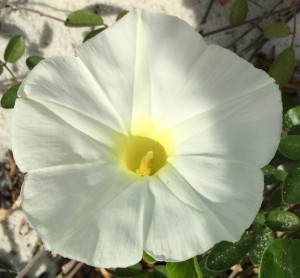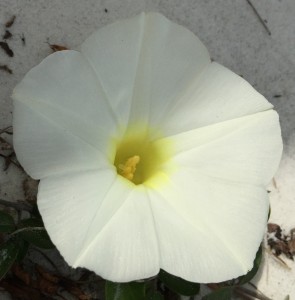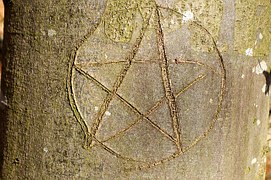Ipomoea obscura, the obscure morning glory, blooms profusely on the white dunes of the Florida panhandle where it binds in place the sands, holding them back from the beaches and breaking waves of the Gulf of Mexico.
This blossom is the same shape, color and form as that of Ipomoea alba, the moonflower, the tropical white morning glory that blooms only at night. The two are identical in appearance, but not in size. The beach morning glory is 2-3 inches (5-8 centimeters) across. The night moonflower can grow to 10-12 inches (25-30 centimeters), the size of a plate.
Ipomoea is a Latin word derived from the ancient Greek words for snake (ipo) and like (moea). The snake-like vines trail, twist and twine along the ground, up the mound and onto lattices and fencing. I have grown the intertwining vines of the morning glory and moonflower on the fences of Texas. Both love the sun. The morning glory is early out. The moonflower delays its night blooms until late in the summer season when the heat has built and the nights grow longer with the approach of fall. It is slow to bloom but larger still.
* * *
The light through the window woke me from sleep. I slipped from my bed, crept quietly through the house and peaked carefully around the curtains and out the window. Under the full moon, the moonflowers waited wide and sparkling white. A shadow raced past and back to hover in fast motion before a bloom.
* * *
The night moth is the size of a small bird. For years, I didn’t know what it was. I know now it is the hawk moth or hummingbird moth. The ones I watched under the full August moon were larger than hummingbirds and never sighted during the day. Fairy dust and moonglow, the zip, dash and hover of their flight was the twinkling of starlight to starflower and the memory of moonflower.
There is another thing about that blossom. Day or night, look closely. Do you see it?
It’s there: The five points of a star. The shaped points of the pentagram rest and reach in that blossom that lights the night and greets the day.
The pentagram or five-pointed star is the oldest of the human-scrivened stars. In the Uruk of Gilgamesh, 5,000 years ago, a pentagram was inscribed on a clay tablet. A 1,000 earlier in the desert sands of the Negev, 6,000 years ago, an ancient artisan sketched the five-pointed star in one fluid motion on a flint scraper.
By our ancestors and children, the pentastar is easily diagramed (pentagram) in five connected lines.
For the life of our kind, there has been the five-pointed star of the morning glory and moonflower. We are the components of that star: head, hands and feet. When we extend and reach, we are the five points and the interlocking triangles of the pentagram. It is the star of our form. We find the point and shape in the lights of the night sky, the blooms of our vines, our selves and the forms of our family members. For its place, the pentagram has fascinated mankind since the beginnings of time.
Carlos Santana has a sound of his own. From Woodstock to today, the mystery and movement of his guitar acoustics have fascinated audiences with the quick flights and slowed motions of sounds that can be heard and sometimes, if you are quiet and watch closely, seen. “Moonflower” was released as a double album in 1977, and the song “Flor d’Luna (Moonflower)” is the second cut on side three.
[embedyt]http://www.youtube.com/watch?v=x5b3VBUW2ok[/embedyt]
Grandpa Jim



